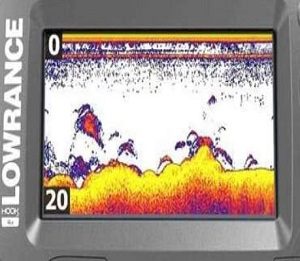 Since the emergence of fishfinders as essential fishing equipment, there are multiple manufacturers that have shown their interest in making the best possible fish finders in order to facilitate people with ultimate ease and comfort.
Since the emergence of fishfinders as essential fishing equipment, there are multiple manufacturers that have shown their interest in making the best possible fish finders in order to facilitate people with ultimate ease and comfort.
Lowrance fishfinders are considered one of the best in the market as they provide anglers, boaters, and anyone on a fishing trip with accurate information on everything underneath their boat. Plus, Fishfinders are very versatile devices as they provide boaters with some useful data regarding the locations of logs, rocks, and other obstacles that may cause boat mishaps.
Not all but some new anglers and boaters often go on fishing with their new device before properly learning how to make the most out of it. As a result, they end up wasting their time in understanding it. Like other equipment, you must also prefer to learn how to read the fish finder first so that you can understand the data shown on it.
How to read a Lowrance fishfinder correctly?
You will see on your Lowrance fishfinder a whole host of information on the display. Most of the information will mean nothing if you don’t know exactly how to read it or what is the purpose of the information given. So, you better learn it. After learning the basic readings of a fish finder, you will be able to make the best use out of it.
How Fish size is determined on sonar
It gets quite difficult to identify fish size on sonar because the size changes according to the sensitivity adjustments or a depth range. It is important to know that fish usually look bigger at a depth range of 20 feet when compared to the depth range of 100 feet. Plus, the size of a fish is sometimes also determined by the thickness of the arch and the colour of the fish arch.
What does the down scan show?
The down imaging is vital to understand as it connects a wider cone which helps to reveal targets. This amazing feature makes the Lowrance down scan much better than the 2D Sonar.
Let’s consider the example that you are searching for fish around trees and weeds. This might confuse you as sonar makes weed and fish look similar.
On your Lowrance Fish Finder, it would be better to get your hands on the down scan feature as it helps to enhance your whole experience. The down scan is more focused on the object than its surroundings.
Side scanning
Searching for a fish using the side scan can be the worst experience. This could be due to the fact that the boat lacks screens. Therefore, sometimes anglers are inclined toward selecting the map, down scanning, and sonar while forgetting about side scanning. Nonetheless, finding fish could turn out to be an easy job if done under the right conditions.
One of the major issues faced regarding side scanning is that sometimes a rocky bottom is so massive that it gives room to fish to hide. But when softer bottoms are shown, the fish is easily visible.
Lowrance 3D Structures
The Lowrance 3D Structures are quite useful and help to target suspended crappie. It comes with a 3D display that actually works like a side-scan but enables you to see the point at which the fish are suspended. Further, the side-scan also shows that the fish is toward the side. Whereas the Lowrance 3D Structure Scan gives you a picture of the fish in the water column.
Map
The Structure Map in the Lowrance fish finder can easily be accessed on the HDS and Carbon. You can also share it with the Hook. For only those who have logged sonar with a side scan, ReefMaster helps you in opening and exporting it as a map. The image becomes your map and it helps you capture very crisp images.
Lowrance trackback
The purpose of the Lowrance Trackback feature is that it enables you to go back in memory to see the image that has disappeared. The Trackback is an excellent feature as it’s not possible to spot a fish right on the spot. Sometimes, it requires checking again to really find what you seek.
Fish ID technology
The best thing about Lowrance fish finders is that they make use of the Fish ID technology in order to detect fish underwater, as well as the materials. The Fish ID technology just simply converts raw data from the water bottom into a user-friendly display interface. It also depends on the fish detected and the useful features beneath the water, the technology shows different icons on the display screen.
On Lowrance fishfinder screens, growing trees or lumbers will be displayed in the form of vertical lines. Whereas the icons representing aquatic vegetation are quite thick and as well as pronounced.
- What Do You Need for Fishing - August 18, 2022
- How to Find Offshore Fishing Spots - August 18, 2022
- What to Use for Trout Fishing - August 17, 2022
